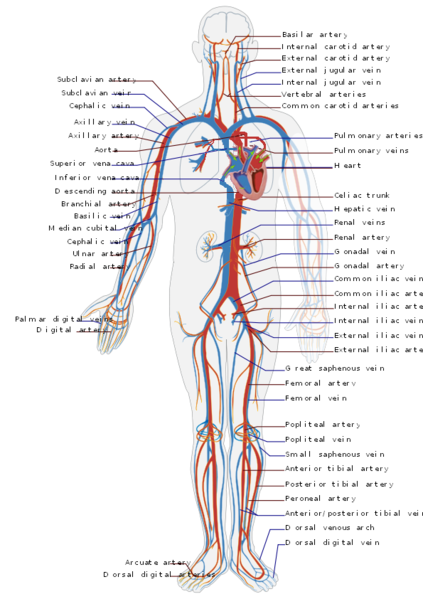A new study published in the American Journal of Human Genetics, expands and deepens the biological and genetic links between cardiovascular disease and schizophrenia. Cardiovascular disease (CVD) is the leading cause of premature death among schizophrenia patients, who die from heart and blood vessel disorders at a rate double that of persons without the mental disorder.
“These results have important clinical implications, adding to our growing awareness that cardiovascular disease is under-recognized and under-treated in mentally ill individuals,” said study first author Ole Andreassen, MD, PhD, an adjunct professor at the University of California, San Diego School of Medicine and professor of psychiatry at the University of Oslo. “Its presence in schizophrenia is not solely due to lifestyle or medication side effects. Clinicians must recognize that individuals with schizophrenia are at risk for cardiovascular disease independent of these factors.”
Led by principal investigator Anders M. Dale, PhD, professor of radiology, neurosciences, psychiatry and cognitive science at UC San Diego School of Medicine, an international team of researchers used a novel statistical model to magnify the analytical powers of genome-wide association studies or GWAS.

These are studies in which differing bits of sequential DNA, called single nucleotide polymorphisms or SNPs, in persons and groups are compared to find common genetic variants that might be linked to a trait or disease. The researchers boosted the power of GWAS by adding information based on genetic pleiotropy, the concept that at least some genes influence multiple traits or phenotypes.
“Our approach is different in that we use all available genetic information for multiple traits and diseases, not just SNPs below a given statistical threshold,” said Dale. “This significantly increases the power to discover new genes by leveraging the combined power across multiple GWAS of pleiotropic traits and diseases.”
The scientists confirmed nine SNPs linked to schizophrenia in prior studies, but also identified 16 new loci, some of which are also associated with CVD. Among these shared risk factors: triglyceride and lipoprotein levels, waist-hip ratio, systolic blood pressure and body mass index.
“Our findings suggest that shared biological and genetic mechanisms can help explain why schizophrenia patients have a greater risk of cardiovascular disease,” said study co-author Rahul S. Desikan, MD, PhD, research fellow and radiology resident at the UC San Diego School of Medicine.
“In addition to schizophrenia, this new analysis method can be used to examine the genetic overlap between a number of diseases and traits,” Desikan said. “Examining overlap in common variants can shed insight into disease mechanisms and help identify potential therapeutic targets for common diseases.”
Notes about this schizophrenia research article
Co-authors include Srdjan Djurovic, University of Oslo and Oslo University Hospital, Norway; Wesley K. Thompson, Andrew J. Schork, J. Cooper Roddey and Linda K. McEvoy, UC San Diego; Kenneth S. Kendler, Virginia Commonwealth University; Michael C. O’Donovan, Cardiff University; Dan Rujescu, University of Halle-Wittenberg, Germany; Thomas Werge, University of Copenhagen; Martijn van de Bunt, Andrew P. Morris and Mark I. McCarthy, University of Oxford; The International Consortium for Blood Pressure GWAS; the DIAGRAM Consortium and the Psychiatric Genomics Consortium Schizophrenia Working Group.
Funding for this research came, in part, from the National Institutes of Health (grants RC2DA029475, R01HD061414 and T32 EB005970), the Research Council of Norway, the South East Norway Health Authority, the Unger-Vetlesen Medical Fund and the Robert J. Glushko and Pamela Samuelson Graduate Fellowship.
Contact: Scott LaFee – University of California San Diego
Source: UCSD press release
Image Source: The schematic of the circulatory system by KVDP at Wikimedia Commons. The image is licensed as public domain. Feel free to use.
Original Research: Abstract for “Improved Detection of Common Variants Associated with Schizophrenia by Leveraging Pleiotropy with Cardiovascular-Disease Risk Factors” by Ole A. Andreassen, Srdjan Djurovic, Wesley K. Thompson, Andrew J. Schork, Kenneth S. Kendler, Michael C. O’Donovan, Dan Rujescu, Thomas Werge, Martijn van de Bunt, Andrew P. Morris, Mark I. McCarthy, International Consortium for Blood Pressure GWAS Diabetes Genetics Replication and Meta-analysis Consortium Psychiatric Genomics Consortium Schizophrenia Working Group: J. Cooper Roddey, Linda K. McEvoy, Rahul S. Desikan and, Anders M. Dale in American Journal of Human Genetics. Published online January 31 2013 doi:10.1016/j.ajhg.2013.01.001







